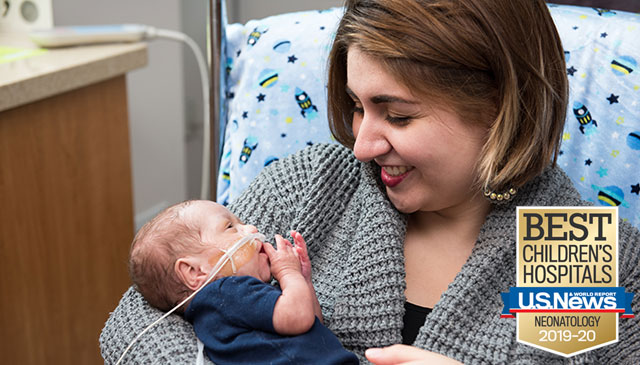
Premature infants and sick infants often need the kind of medical attention and care only found in a newborn intensive care unit like Texas Children’s Hospital Newborn Center.
Named No. 7 in the nation by U.S. News & World Report 2019-2020 Best Children’s Hospitals rankings, The Neonatal Intensive Care Unit (NICU) at Texas Children’s Hospital is designated by the Texas Department of State Health Services as a level IV NICU, the highest level of care available for premature and critically-ill newborns.
More than 1,800 infants are cared for each year in the Texas Children’s Neonatal Intensive Care Unit (NICU), making us one of the largest, most experienced NICUs in the country. We provide all services that critically ill or premature babies might need, including on-site neonatologists available 24/7, the highest level of respiratory support, advanced imaging, pediatric surgery, pediatric anesthesiology and more.
Texas Children’s NICU is led by a multidisciplinary team of neonatal experts – physicians and nurses who are internationally known for their level of experience and knowledge in the care of premature and critically ill infants. They serve on committees and consortiums that set the standard of care for newborn care nationally and conduct research on a range of topics in perinatal and newborn medicine.
“I am extremely excited that our neonatal team has been named again as one of the best in the nation,” said Chief of Neonatology Dr. Gautham Suresh. “As a Level IV NICU, our neonatal team has the resources and expertise to deliver the highest level of care available for premature and critically ill newborns.”
Texas Children’s Newborn Center is continuously ranked by U.S. News as one of the best places in the nation to receive pediatric care. The rankings use a well-accepted framework for evaluating quality of health care, which factors in patient outcomes, such as mortality and infection rates; available clinical resources; and compliance with best practices. Improved rankings demonstrate a health care organization’s commitment to not only providing high-quality care, but also to identifying gaps where improvements are needed.
Big wins for patients and families
This past year, the Newborn Center built on its legacy of success and implemented new initiatives to increase transparency, reduce risk of infection and improve the quality of care. Here are some of the center’s big wins for patients and families:
Increased the number of infants discharged drinking their mother’s milk.
Studies have found that when infants receive their mother’s milk at discharge they are more likely to breastfeed and/or breast milk feed for longer. To encourage this behavior, the Keeping Abreast Quality Improvement work group was formed to identify areas for improvement involving human milk feeding and direct breastfeeding in the Newborn Center. From this group, two sub-groups were formed to optimize colostrum for oral care and infant-driven feeding. Colostrum is the first fluid produced by the breast after birth and is rich in nutrients, immune and growth factors. The work of these groups helped increase by 15 percent the number of infants discharged drinking their mother’s milk. This year, 1,024 infants were discharged drinking their mother’s milk compared with 894 last year. A bar coding system for correct breast milk identification also was implemented. The system decreases the likelihood of milk misappropriation.
Achieved a less-than-24-hour turnaround time for urine organic acid and amino acid on-site analysis. The 24-hour turnaround time on urine organic acid and amino acid tests has important implications for newborns. These tests help clinicians diagnose newborns with inborn errors of metabolism, a group of disorders caused by defects in pathways that are crucial for metabolizing food and turning it into a source of energy. Prompt diagnosis of these conditions is important as it allows us to start targeted treatments and initiate dietary changes without significant delay. Rather than presuming the diagnosis and implementing generalized treatment plans, we are able to customize specific treatment plans based on the diagnosis and counsel families accordingly.
Emergent neonatal transports were dispatched within 30 minutes of being requested.
This improvement was made by strengthening partnerships between neonatal nurse practitioners and members of the Neonatology and Transport service team. To ensure the neonatal nurse practitioners were able to respond to the transport team when a transport request was made, a float neonatal nurse practitioner was scheduled and dedicated to such requests. When a float neonatal nurse practitioner was not available, the neonatal nurse practitioners on the floor were empowered to provide a short, succinct checkout to the neonatologist or fellow neonatal nurse practitioner to ensure a timely dispatch time.
Increased the number of registered nurses with neonatal intensive care certification.
The number of registered nurses with neonatal intensive care certification increased 14 percent in 2019 compared with 2018. Our rate of 55 percent is higher than the required certification rate of 51 percent prescribed by Magnet. As noted by the American Nurses Credentialing Center (ANCC), certification affirms advanced knowledge, skill, and practice to meet the challenges of modern nursing. Increasing/maintaining our certification rate is important because research findings have demonstrated a relationship between higher rates of nursing specialty certification and lower rates of negative patient outcomes, such as falls, hospital acquired pressure injuries, select hospital acquired infection rates and failure to rescue and death.
All attending physician extenders participated in a competency simulation for an infrequently performed procedure (chest tube placement) in the past 24 months.
It’s important that all health care providers in the Neonatal Intensive Care Unit are competent in performing key life-saving procedures. Some of these procedures are used rarely, therefore we provide refresher courses and measure each provider’s competency in performing these procedures using hi-fidelity simulation. This allows our providers to feel confident in their skills and be ready to perform them when necessary.

